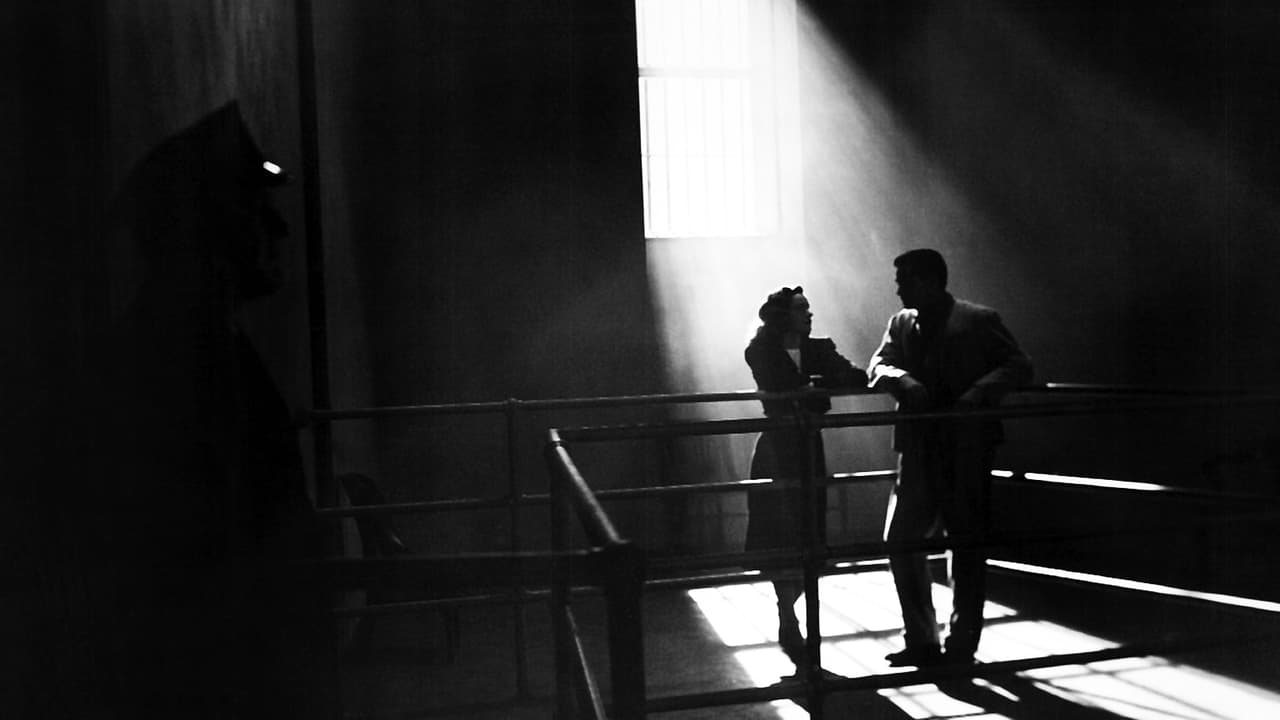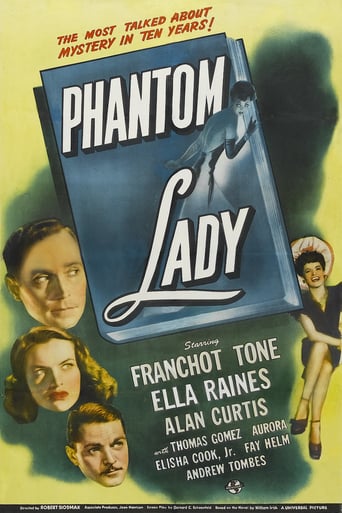Redwarmin
This movie is the proof that the world is becoming a sick and dumb place
Senteur
As somebody who had not heard any of this before, it became a curious phenomenon to sit and watch a film and slowly have the realities begin to click into place.
Leoni Haney
Yes, absolutely, there is fun to be had, as well as many, many things to go boom, all amid an atmospheric urban jungle.
Staci Frederick
Blistering performances.
poe-48833
PHANTOM LADY (not to be confused with the Golden Age comic book with art by Matt Baker) comes from the mind of "William Irish" (Cornell Woolrich, who also gave us the stories that became the Noir movie classics THE WINDOW and REAR WINDOW). If anyone knew anything about the Twists and Turns of the Psyche, it was Woolrich (see the biographical information in many of the best collections of his short stories at your local Public Library); that PHANTOM LADY winds its way through a Mystery with so many Dead Ends and What-the-F---s isn't surprising. (On the other hand, like Raymond Chandler himself, Woolrich could sometimes forget or overlook a plot point or two- and so do the Screenwriter and Director, here.) If you're one of those who INSISTS that all one's ducks be properly aligned, you're going to have a problem or two here and there- but, if you can enjoy for the sheer Naughtiness of it Elisha Cook, Junior's "drum solo," you're in for a Fun Ride.
disinterested_spectator
This movie has one of the most contrived and illogical plots in cinematic history. Scott Henderson and his wife have an argument, and he leaves their apartment and goes to a bar. Shortly after, his wife is strangled by Jack Marlow, with whom she was having an affair. Because there is no evidence connecting him with her murder, the police never suspect him, and so all he has to do is take the trip to Brazil as planned.But no! He decides that he must make sure that Henderson is suspected of the crime. So, he only pretends to get on the ship and then slips off and follows Henderson around (he catches up with the ship later by taking a plane to Havana). He sees that Henderson meets a woman in a bar, whom he persuades to go to a show with him, inasmuch as he already has tickets. She agrees, and they take a cab. They sit right up front, and it turns out that she is wearing the same unusual hat worn by the star of the show, Miss Montiero. The drummer takes a fancy to the woman with Henderson and flirts with her.So, Marlow figures he must bribe the bartender, the cabdriver, and the drummer to say they never saw the woman, thereby depriving Henderson of his alibi. Marlow does not have to bribe Miss Montiero, because her vanity won't let her admit that someone in the audience wore the same hat that she did, which she apparently disposed of. Of course, other women in the show might have remembered Miss Montiero's hat, and other members of the band might have noticed the woman in the front row with the hat, but Marlow does not bother to bribe any of them.As a result, the bartender says he saw Henderson at the bar, but not the woman; and the cabdriver says he picked up Henderson and drove him to the show, but there was no woman with him. And so, without an alibi, Henderson is convicted of murder on the flimsiest of circumstantial cases and sentenced to be executed. However, no one in the movie seems to realize that the bartender and cabdriver have provided Henderson with an alibi anyway. Whether he had a woman with him is irrelevant. For that matter, if Marlow was going to bribe these characters, he should have told them to deny seeing Henderson rather than deny seeing the woman with him. Had he done that, then the woman would be the only one who could provide Henderson with an alibi, and the frantic search for her would have made sense.It gets worse. Although there are only a few weeks until Henderson will be executed, Marlow returns from Brazil and decides to murder the drummer when he sees Carol, Henderson's assistant, trying to get information out of him. Even so, there still would be no evidence connecting him with that murder either, except that he picks up Carol's purse, which she left behind when the drummer became angry, and puts it in a drawer in his apartment.These do not exhaust the absurdities in this movie, which pile up on top of the ones already discussed, but there is no point in beating a dead horse. And because we immediately become aware of these absurdities as they unfold, watching the movie can be an exasperating experience.
rafael105
The wired jazz scene with Elisha Cook banging away at the mad drums is worth the whole movie. Plus, there's Ella Raines, looking lovelier than ever. This movie must have really disturbed 1944 audiences. There's a psycho murdering sculptor with strong hands and a fatal weakness. There's fat nasty policemen who breathe down everyone's necks. There's Aurora Miranda trying to steal sister Carmen's act. There's lots of sweating in the August swelter of New York. There's plenty of bad acting and bad dialogue. But, there are also some really unusual shots of street scenes during the long sequence in which Ella pursues the bartender to his death. Strong stuff, indeed. And, did I mention there's Ella Raines looking lovelier than ever? I think I'm in love.
Spikeopath
Phantom Lady is directed by Robert Siodmak and adapted to screenplay by Bernard C. Schoenfeld from the story written by Cornell Woolrich (pseudonym William Irish). It stars Ella Raines, Franchot Tone, Alan Curtis, Thomas Gomez, Elisha Cook Jr and Fay Helm. Music is by Hans J. Salter and cinematography by Woody Bredell.Out drowning his sorrows, Scott Henderson (Curtis) meets an equally unhappy woman in a bar, agreeing to her request to not exchange names, but to merely enjoy each others company, Henderson takes her to a show. Upon returning home Henderson finds his wife has been strangled and he is arrested as the prime suspect for the murder. When he frantically tries to prove he has an alibi by way of the "phanton lady" he spent the evening with, he comes up against a wall of silence with nobody able to prove he was with anybody. The electric chair awaits unless someone can prove his alibi. Enter Henderson's intrepid secretary Kansas Richman, who not only carries a torch for her boss, but appears to be his only hope of proving his innocence...An important film in the film noir cycle given that its success kicked opened further the American doorway for German director Robert Siodmak (The Killers); something that all fellow film noir fans are eternally grateful for. Often cited as a top draw noir or one of the best from the early 40s output, it's a frustrating experience in many ways. Undeniably the middle third is an absolute visual treasure, where Siodmak and Bredell (also The Killers) craft the essential film noir style with highly detailed shadows and lighting gaining maximum atmospheric impact. An extended sequence that sees the wonderful Raines (Impact) stalk a witness through dark and dank streets to a subway station is clinical in its photographic brilliance. I love the quote from Bredell where he said that after being coached by Siodmak he felt he could light a football pitch with only a match! This middle third of Phantom Lady is the meeting of two visual minds and it's a class combination.Elsewhere Siodmak emphasises objects and weird art to keep his world off kilter, while a key character's obsession with his hands also keeps things simmering in the realm of the strange. There's also a "famed" suggestive sex scene as Elisha Cook Jr (as always, memorable) pounds his drum kit to a climax as Raines positively smoulders in front of him. All of these things are set to the backdrop of a ticking clock format, where the innocent Henderson's life hangs in the balance. These are all film noir traits and executed with such skill it hides the fact that the film is primarily studio bound, in fact this can be seen as a marker for how to do "studio noir" effectively.Unfortunately there is good reason why Phantom Lady is divisive in film noir circles. The dialogue is often plain daft, almost as daft as the plot itself. The murderer is revealed at the mid point and therefore we are robbed of the mystery element and sadly it sign posts the finale as being obvious and disappointing. Plot in the final third puts our heroine in constant danger at the hands of the real murderer, suspense is meant to be wrung out, but it never hits home the way it should. While on the acting front Curtis is too stiff to really make a telling innocent man hanging by a thread character and Tone is equally as flat in a critical role. However, do these things stop Phantom Lady from being a great film? No, I don't think so, there's just too much good in the mix to stop it from deserving some of the (admittedly exaggerated) praise put its way. 7.5/10

